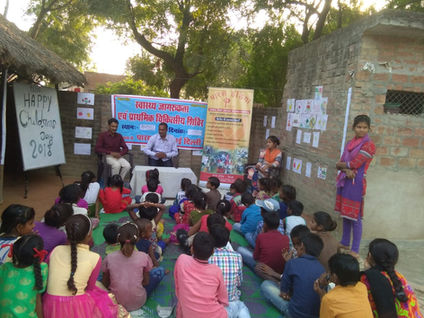

Home > Our Projects > Prayas
PROJECT DETAILS
Health is more than a medical issue. With every illness talked about, there is space for public policy, awareness campaigns, education, sanitation and nutrition, apart from accessible medical facilities, to have being made a difference. With this context in mind, we started Prayas in Bundelkhand, Chattisgarh and urban slums of Delhi ever since 2011. Through nukkad nataks and interactive sessions, our team tries to clear various doubts about health, hygiene, reproductive health and bring awareness regarding unhealthy lifestyle.
As we know that the health injuries caused by the poor human living environment is highest in urban slums and tribal and poor communities, we have started the initiative of PRAYAS with the aim of-
-
We are creating health awareness among communities regarding various diseases like vector-borne diseases, family planning, pregnancy, delivery, newborn care, breastfeeding, childhood malnutrition, swine flu, HIV/AIDS etc.
-
To bring in healthcare professionals to connect with the residents for primary healthcare services. Paras also attempts to facilitate target population with essential medicines. To do so, we distribute free medical kits and basic medication regularly through our medical camps.
PRAYAS IN BUNDELKHAND
Healthcare in UP can be summarised as a composite challenge of access, quality and demand. In UP, 85% of medical needs are met by unrecognised doctors and quacks according to the report. The average cost of treatment at sub centres and PHCsis Rs 660 per person which is more than double the national average of Rs 312 per person as per Ministry of Statistics report.
This data provides compelling reasons for health camps to be organised by NGOs to fulfill the gap in the healthcare sector. With this aim in mind, PRAYAS in Bundelkhand was initiated to generate healthcare awareness among the community.
PRAYAS IN CHATTISGARH
As a predominant share of the population of Chhattisgarh being tribal, and because it was initially a part of a big state Madhya Pradesh, it was deprived of the gains of development process. The District Level Household Survey 3 point out to the fact that only 9.8% of the rural person in Chattisgarh have access to toilet facility, while only 4.1% in the rural Chattisgarh use piped drinking water. This is an open invitation to communicable diseases. Added to that,the human resources gap, poor physical infrastructure, and other supply-side gaps compound the problem. Lack of poor community participation in public health interventions carried out by the government, with superstitions running high makes it extremely important to reach these rural areas under PRAYAS.
PRAYAS IN URBAN SLUMS OF DELHI
Ever increasing unplanned urbanization has lead to large-scale emergence of slums in the cities. As a consequence of it, overpopulation in has given birth to a different set of problems unique to the urban slums.
Human living conditions in the absence of basic civic amenities such as safe and adequate water supply, sewerage and sanitation and toilets, has been precarious and miserable for the health, safety and comfort in such communities. It is found that respiratory diseases among the urban poor are very high. Due to their unhealthy site location and living and working in pollution-prone environment, it is easily perceived that it is the urban poor who are bearing the brunt of increasing urban environmental problems.
ACHIEVEMENTS
-
There have been as many as 3,12,41 beneficiaries of our health campaigns.
-
Our awareness camps have made people realize the importance of keeping hygienic and sanitary practices as a precursor for better lives.
-
The whole exercise helped people in voicing out their health grievances to our team of doctors. People did not seek professional healthcare earlier.
-
Community members, as a result of our awareness camps, have formed a nukkad natak team on their own to aware people nearby of healthy practices.
-
People are aware about various government schemes on health, health insurances,
and fund for cancer patients for poor families and generic medicines available for them.




